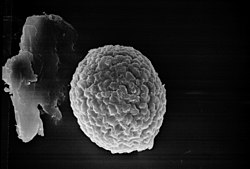| Tilletia | |
|---|---|
 | |
| Teliospore of Tilletia indica | |
| Scientific classification | |
| Domain: | Eukaryota |
| Kingdom: | Fungi |
| Division: | Basidiomycota |
| Class: | Exobasidiomycetes |
| Order: | Tilletiales |
| Family: | Tilletiaceae |
| Genus: | Tilletia Tul. & C.Tul. |
| Type species | |
| Tilletia caries (DC.) Tul. & C.Tul. | |
Tilletia is a genus of smut fungi in the Tilletiaceae family. Species in this genus are plant pathogens that affect various grasses. Tilletia indica , which causes Karnal bunt of wheat, and Tilletia horrida , responsible for rice kernel smut, are examples of species that affect economically important crops. [1]
Contents
The widespread genus contains about 175 species. [2] The genus was circumscribed by Edmond Tulasne and Charles Tulasne in Ann. Sci. Nat. Bot. ser.3, vol.7 on page 112 in 1847.
The genus was named after a agronomist from France, Mathieu Tillet (1714–1791). [3]